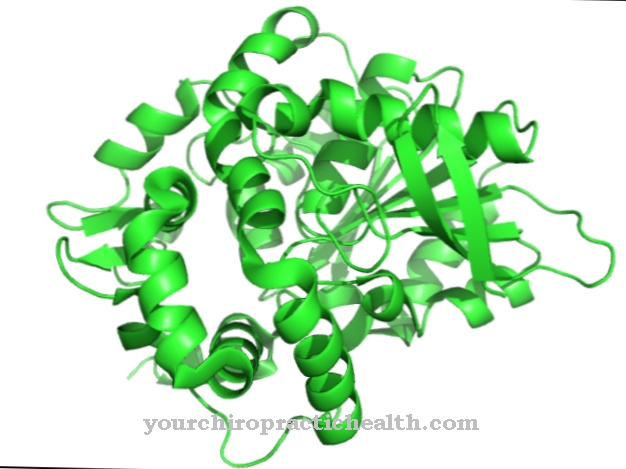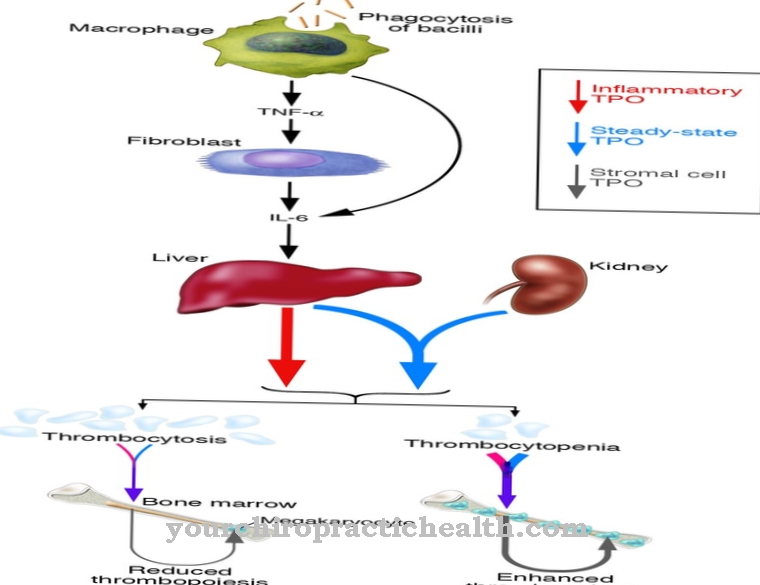Nucleases are enzymes whose function is to break down nucleic acids such as ribonucleic acid or deoxyribonucleic acid. This is referred to as complete or partial digestion of the substrate.
What are nucleases
Nucleases are generally responsible for the breakdown of nucleic acids. The nucleic acid can be broken down both from the ends of the nucleic acid molecules and from its center.
There are also so-called restriction nucleases, which cut out nucleic acid sequences only from certain regions. The nucleases are classified according to various criteria. One criterion is the type of nucleic acid (deoxyribonucleic acid or ribonucleic acid). Another criterion concerns the secondary structure such as double strand or single strand. It is also important for the selection of the criteria whether the degradation takes place from the ends or from the middle of the molecule. The next question is where the attack site is located between the 5 'and 3' positions of the sugar-phosphate structure.
The role of the sequence-specific and unspecific base sequence also flows into the determination of the classification criteria. According to these criteria, there are various classification classes. The nucleases can be classified into exonucleases, endonucleases, deoxyribonucleases and ribonucleases.
Function, effect & tasks
The functions of the nucleases are diverse. An important function is to cleave foreign DNA or RNA both sequence-specific and non-specific. The restriction endonucleases are responsible for this task.
They split the nucleic acids at certain points away from its ends. Either similar nucleic acid sequences are split off or unspecific sequences arise. The restriction endonucleases are part of the immune system because they break down foreign nucleic acids. Nonspecific nucleases are often responsible for the digestion of nucleic acids. However, they also digest the nucleic acids of the dead cells during programmed cell death, apoptosis. DNase, which occurs particularly in the pancreas, liver, platelets and blood plasma, plays a major role here.
The mRNA is influenced by the presence of RNases. The controlled breakdown of RNA controls the regulation of gene expression. The exonucleases break down the individual DNA or RNA molecules from the ends. The nucleic acid sequence is irrelevant here. The function of these enzymes is to completely break down the nucleic acids into the corresponding nucleotides. The nucleotides either serve as building blocks for the rebuilding of nucleic acids or they are broken down entirely. In genetic engineering processes, restriction nucleases are used as molecular cutting tools for the targeted removal of undesired nucleic acid sequences.
Education, occurrence, properties & optimal values
The distinction between DNases and RNases is a particularly important differentiation criterion. DNases break down DNA. There are both neutral and acidic DNases. The neutral DNases are particularly formed in the pancreas, liver, blood plasma and platelets. There they control the breakdown of DNA as part of apoptosis.
The degradation of the DNA by means of neutral DNase leads to the formation of nucleoside'-5-phosphates. In order not to break down the genetic material unspecifically, the neutral DNase forms a complex with the protein actin. This complex is considered to be a storage form of the nuclease. Acid DNase (DNase II) is also present in the pancreas and blood plasma, but also in urine and breast milk. With the help of the acidic DNase the DNA is split into nucleoside´-3-phosphates. The RNases show a greater variety. About 50 different RNases are known in humans, 9 of which are related to rare hereditary diseases.
The RNases can in turn be divided into exoribonucleases and endoribonucleases, depending on whether the RNA is degraded at the ends or split within the strand. Among other things, the RNases have an important function in gene regulation by specifically limiting the lifespan of tRNA. They also support the tailor-made production of new RNA. Furthermore, as part of the immune system, they are involved in the fight against invading viral RNA. The most important RNases include RNase A, RNase H, RNase P, RNase R and RNase D. RNase A specifically splits the RNA according to a pyrimidine nitrogen base such as uracil or cytosine. It is particularly found in sweat and breaks down viruses there before they can penetrate the organism.
That is why it is often referred to as an environmental nuclease. RNase H acts unspecifically in DNA-RNA heteroduplexes, where it breaks down the RNA fraction. A heteroduplex made of RNA and DNA is a double strand made up of the two different types of nucleic acids. RNase removes the RNA monomers mistakenly built into the DNA and replaces them with DNA monomers. RNase P removes the precursor in the production of tRNA. RNase R helps break down bacterial mRNA and RNase D is responsible for processing tRNA.
Diseases & Disorders
Nucleases are enzymes whose lack or malfunction can lead to serious physical complaints. As already mentioned, nine RNases are associated with very rare hereditary diseases.
For example, if RNase H is insufficiently active, mutations, strand breaks and the accumulation of DNA sequences in the RNA occur. The so-called Aicardi-Goutières syndrome develops, which manifests itself in children as attacks of fever, vomiting and fidgety. Some infants lose their motor skills after a few months. Many patients die in early childhood. The cause of these symptoms are inflammatory reactions that are mediated by immune reactions to the enriched DNA segments in the RNA.





.jpg)






.jpg)



.jpg)










.jpg)
